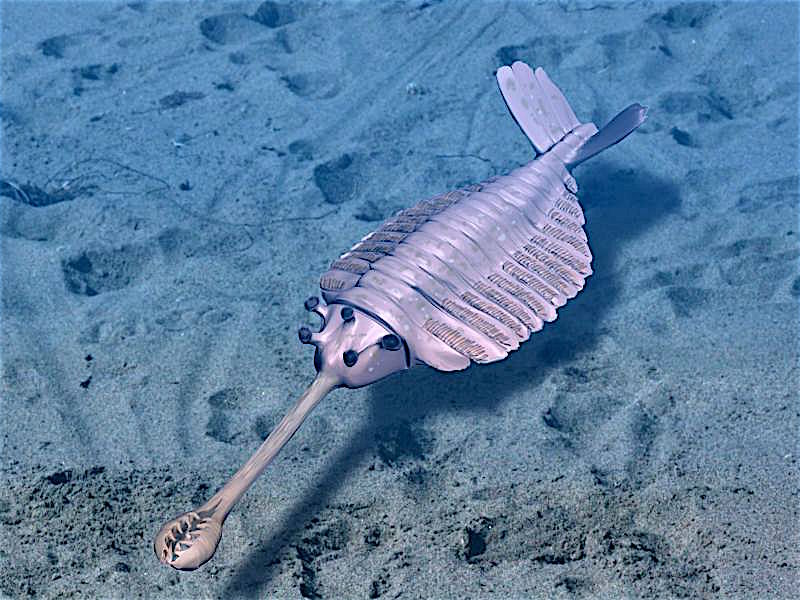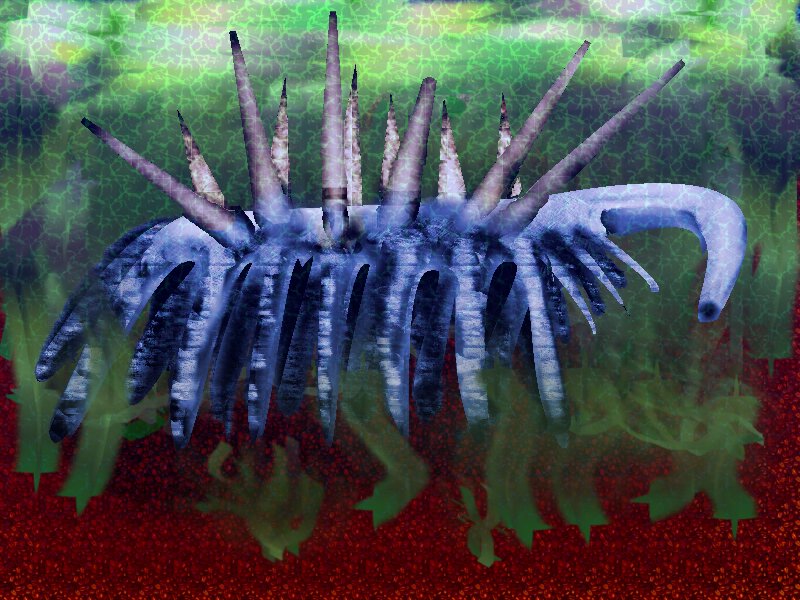Standing in awe, we were mesmerized by what lay before us. The distant, western edge of the Canadian Rockies rose tall, rugged, barren of trees, and - true to their name - rocky. Below, lesser hills blanketed with deep green velvet forests. Lower still, the rich aquamarine reflection of both in a mirror image spread across a crystal clear, glass-smooth body of water appropriately called Emerald Lake. In the still, crisp, early autumn morning, the silence was truly deafening. Except for one or two early walkers, we were the only ones there, which made the experience all the more memorable.
At the small picnic area along the shore, we paused to read about the site, then squinted through a telescope at the distant spot along a rocky ridge, 1,700 feet above. It was there in the early 1900s that Charles Walcott, third director of the United States Geological Survey, and later, head of the Smithsonian Institution, made a phenomenal discovery.
Mark A. Wilson
Millions of soft-bodied sea creatures, most never before seen, were forever preserved as fossils in what is now known as the Burgess Shale formation. Walcott spent every summer from 1907 to 1925 in the Rockies, mapping the thick Cambrian formations clear to Banff. Although he shipped his fossils - 65,000 specimens on 30,000 slabs - back to the Smithsonian Institution in Washington DC, his duties there prevented him from studying them in much detail. He did describe most in notes & photographs, but all of this lay in drawers for nearly 50 years, until a modern generation of researchers dusted them off and set to work, beginning in 1973. Smith609
Millions of years ago a calm, shallow sea existed along the edge of a huge, rocky escarpment there. With constant erosion, fine clay mud settled through the water slowly but continuously, gradually building up layers of sediment on the sea floor. Within this nutrient-rich area, a myriad of small, bizarre sea creatures flourished until, around 500 million years ago, they somehow met their demise. Scientists believe that they were buried very quickly and close to where they lived by sudden mudflows, which allowed for very slow decomposition and near-perfect preservation of their forms. On some, they can even discern internal organs and what they ate the day they died!
Keith Schengili-Roberts
What amazes me is the sheer number and diversity of the species found - 170 so far. Ranging from 1 to 12 inches long, many of these ancient creatures had segmented bodies and jointed legs, resembling today’s shrimp or crab. Some looked like weird worms, slugs, or squid. And trilobites, lots and lots of different trilobites. One thing is sure - none of those creatures live on earth today.
Nobu Tamura
Over time, earth has changed significantly and continues to do so today. There is much discussion and controversy over what, exactly, causes these changes. Humans do impact the environment, but as far as we know, none of our kind was around back when the Burgess Shale creatures disappeared in what is now Yoho National Park. Rocks tell us much - but they don’t tell all.
Scorpio 451
And God said, “let the waters teem with living creatures...” So God created the great creatures of the sea and every living and moving thing with which the water teems, according to their kinds... And God saw that it was good. God blessed them and said, “Be fruitful and increase in number and fill the water in the seas...” Genesis 1:20-22
For more on the Burgess Shale Formations:
Fossil picture files from Wikimedia Commons







I stayed overnight at a resort in Emerald Lake... or rather outside of Emerald Lake. The resort would have been expensive except that I was there in late September and snow was forecast for later that week. I had the most magical horseback ride along that treeline area in high 60s temps with sun and just a touch of breeze. It was just me and the trail guide for a couple of hours early in the morning before I checked out and headed over the pass to Jasper. I stopped at the top of the pass to look at the glaciers there but missed the ones in Emerald Lake (maybe didn't get that far west.)
ReplyDelete